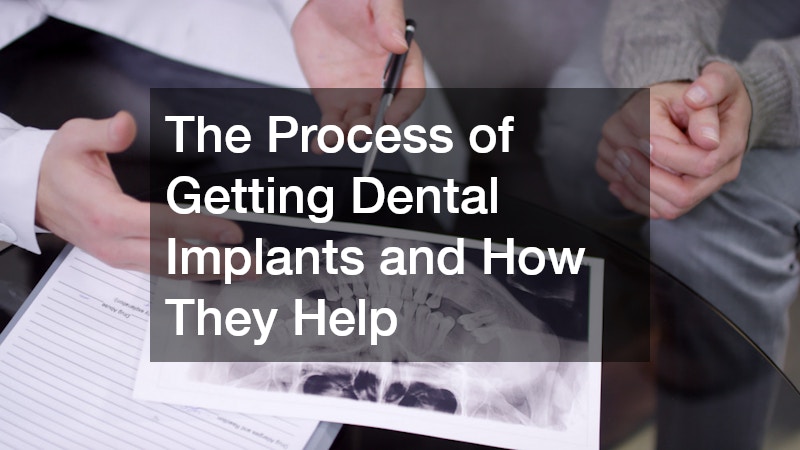Dental implants are a modern solution for replacing missing teeth and restoring a healthy, functional smile. They provide a long-term alternative to traditional dentures or bridges and can significantly improve both oral health and quality of life. This article explores the process of receiving dental implants, the benefits they offer, and why they have become a preferred choice for tooth replacement.
What Are Dental Implants?
Dental implants are artificial tooth roots made from biocompatible materials, typically titanium, that are surgically placed into the jawbone. They provide a stable foundation for replacement teeth, including crowns, bridges, or dentures.
Definition and Components of Dental Implants
A dental implant consists of three main components: the implant post, the abutment, and the crown. The implant post is surgically embedded into the jawbone and acts as the root. The abutment connects the implant to the replacement tooth, and the crown is the visible portion that looks and functions like a natural tooth. These components work together to provide stability and durability.
The History and Evolution of Dental Implants
Dental implants have evolved significantly over the past several decades. The concept of replacing teeth with artificial roots dates back thousands of years, but modern implants began with the discovery that titanium can fuse with bone through a process called osseointegration. Advances in materials, surgical techniques, and imaging technology have made implants safer, more predictable, and more accessible.
Types of Dental Implants Available
There are several types of dental implants to meet different needs. Endosteal implants are the most common and are placed directly into the jawbone. Subperiosteal implants are placed under the gum but above the jawbone and may be used in patients with insufficient bone. Mini implants are smaller in size and often used to stabilize dentures or in cases with limited bone volume. Each type is selected based on the patient’s oral health, jaw structure, and treatment goals.
Benefits Over Traditional Dentures and Bridges
Dental implants offer several advantages over traditional dentures and bridges. Unlike dentures, implants are fixed in place and do not slip or require adhesives. Unlike bridges, implants do not require grinding down neighboring healthy teeth. They provide improved stability, comfort, and natural appearance, making them a preferred choice for many patients.
When Are Dental Implants Necessary?
Dental implants may be recommended for individuals who have lost one or more teeth due to decay, injury, or periodontal disease. They are also suitable for patients who want to improve their oral function, prevent bone loss, and restore their smile permanently. A dentist or oral surgeon evaluates each case to determine if implants are the best solution based on oral health, bone density, and overall medical condition.
How Is the Dental Implant Procedure Performed?
The dental implant process involves several steps, each designed to ensure safety, precision, and successful integration with the jawbone.
Initial Consultation and Assessment
The process begins with a comprehensive dental examination and consultation. The dentist evaluates the patient’s oral health, bone density, and medical history. X-rays, CT scans, or 3D imaging may be used to plan the optimal placement of the implant and assess the condition of surrounding teeth and bone.
Preparation and Planning: Imaging and Design
Once the assessment is complete, the dentist or oral surgeon creates a treatment plan. This plan includes the type of implant, the placement location, and the design of the replacement tooth. Detailed imaging ensures accurate placement, which is critical for proper function and aesthetic results. In some cases, bone grafting may be performed prior to implant placement if there is insufficient bone to support the implant.
Surgical Placement of the Implant
During the surgical procedure, the implant post is carefully inserted into the jawbone. The site is numbed using local anesthesia, and sedation may be provided if necessary. The dentist ensures precise placement for optimal alignment and stability. After the implant is placed, the gum tissue is closed over the post, and a healing period begins.
Healing and Osseointegration Process
The healing process, known as osseointegration, allows the implant to fuse with the jawbone. This process typically takes several months and is essential for providing a stable foundation for the replacement tooth. During this period, patients may receive a temporary crown or denture to maintain function and appearance. Regular follow-up visits ensure that healing progresses as expected.
Placement of the Abutment and Crown
Once the implant has fully integrated with the bone, an abutment is attached to the post. The abutment connects the implant to the final restoration. The dentist then fabricates and places the crown, which is customized to match the color, shape, and size of surrounding teeth. This final step completes the dental implant process and restores full oral function.
What Are the Benefits of Dental Implants?
Dental implants provide both functional and aesthetic advantages that improve oral health and overall quality of life.
Improved Appearance and Confidence
Implants look and feel like natural teeth. They restore the appearance of the smile, boost self-esteem, and allow individuals to speak, eat, and laugh with confidence.
Enhanced Oral Functionality
Dental implants provide strong, stable support for chewing and speaking. Unlike removable dentures, they do not slip, allowing patients to enjoy a normal diet without discomfort or limitations.
Longevity and Durability of Implants
With proper care, dental implants are highly durable and can last for decades. They are resistant to decay and often outperform other tooth replacement options in longevity.
Prevention of Bone Loss and Preservation of Facial Structure
Implants stimulate the jawbone, helping prevent bone loss that can occur after tooth loss. They maintain facial structure and prevent the sunken appearance often associated with missing teeth or prolonged denture use.
Overall Health Improvements
Replacing missing teeth with implants supports better oral hygiene and reduces strain on remaining natural teeth. This can prevent future dental issues, improve nutrition, and contribute to overall health.
Conclusion
Dental implants offer a reliable and long-lasting solution for missing teeth. The process involves careful assessment, surgical placement, healing, and final restoration, ensuring optimal function and appearance. Implants provide benefits that extend beyond aesthetics, including improved oral function, preservation of bone and facial structure, and enhanced confidence. By understanding the procedure, potential benefits, and proper maintenance, patients can make informed decisions about their oral health. Dental implants are an investment in both a healthy smile and overall quality of life.




